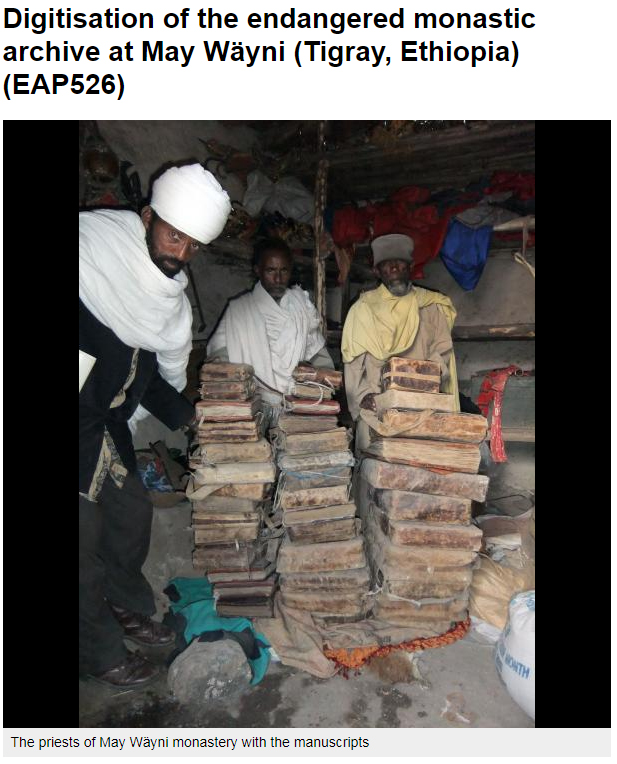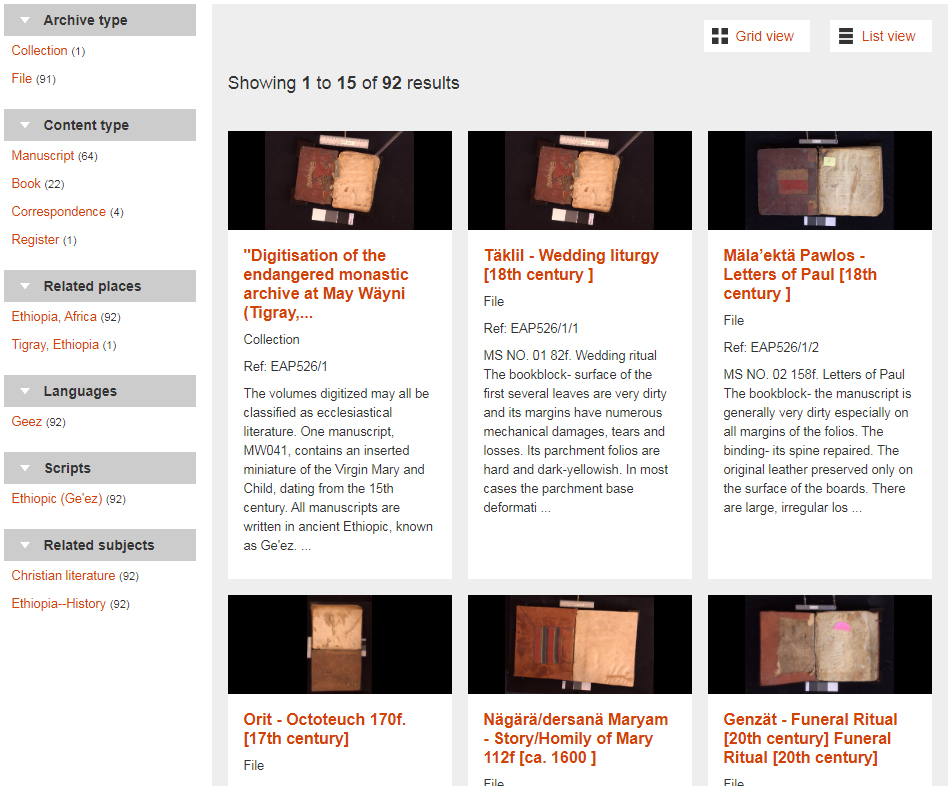|
Digital meets Culture https://www.digitalmeetsculture.net/article/digitisation-of-the-endangered-monastic-archive-at-may-wayni-ethiopia/ Export date: Wed Dec 24 9:16:59 2025 / +0000 GMT |
Digitisation of the endangered monastic archive at May Wäyni, EthiopiaText by Caterina Sbrana. I have already spoken in my blogs about the importance of the digitisation of historical documents in order to enable them to be used and disseminated worldwide through the Internet. There is another reason why digitisation is important and this is the preservation of endangered documents. The term ‘endangered' is related to those historical materials, documents, manuscripts, paintings that for various causes are at risk of being destroyed and are located in countries where resources and opportunities to preserve them are lacking or limited. An example of this work is conducted by the British Library in London through the Endangered Archives Programme (EAP), with the financial support of the Arcadia Fund, a charitable fund established by Dr Lisbet Rausing and Professor Peter Baldwin. Within the EAP, the project team consisting of Professor Michael Gervers (University of Toronto), Professor Ewa Balicka-Witakowska (Uppsala University), Professor Jan Retsö (Göteborg University) and Dr. Jacek Tomaszewski (Institute of Oriental Art, Warsaw) worked on the digitisation of the 91 manuscripts belonging to May Wäyni monastery, in the region of Tigray, in northern Ethiopia. Other drawings as well as miniatures have been independently digitised.  Screenshot of the home page of EAP, regarding the May Wayni manuscripts. We can see three priests who show the ancient manuscripts; https://eap.bl.uk/project/EAP526 In the introductory page of the project it is possible to read the primary objective of this work: “Since the old church of May Wäyni and its storage facility recently collapsed, and the construction of the new church has stopped due to lack of funds, the manuscripts are presently stored in a primitive hut, lying on the floor or on rough benches. Regularly used liturgical books reside in the altar unit in the unfinished sanctuary. Types of damage include accumulation of mould, ravages of mice, male caterpillar holes, water damage, burning, and detached and torn folios. […] The collection at May Wäyni contains numerous specimens of high interest to scholars working on Ethiopian literature and ecclesiastical history. It is threatened, however, by minimal protection in a roughly built structure suffering from near collapse. To prevent further damage to the manuscripts, the monks have distributed those not used during the daily services (including the old biblical texts) among the monks and villagers. This arrangement is particularly unfortunate as it is leading to the increased dispersal of the manuscripts, many of which will find their way to the market place before their content has been recorded. The collection of manuscripts will be cleaned and placed in improved storage conditions. Digital copies will be deposited with local and international institutions.” The Archival records are divided into some sections such as “File”, “Manuscript” “Ge'ez” the ancient Ethiopic, a subdivision that allows the researcher to immediately access the documents and informations.  By clicking on "View archives from this project" we find different sections and we can select our search; https://eap.bl.uk/project/EAP526/search On the website you can read an open access article entitled: "Technological aspects of the monastic manuscript collection at May Wäyni, Ethiopia", which is signed by Jacek Tomaszewski and Michael Gervers. This study is part of the book From Dust to Digital and can be also downloaded free of charge as a Pdf. Its use is under a Creative Commons Attribution Non-commercial Non-derivative 4.0 International license (CC BY-NC-ND 4.0). Therefore it is possible to share, copy, distribute and transmit for personal and non-commercial use providing author attribution is clearly stated. The article presents the monastic site where the manuscripts are kept, describes the collection and its state of conservation. Some manuscripts are in bad condition and many pages are eaten by rodents and bacteria. The study also notes that most of the damage is found mainly in the margins of the pages. The publication contains the list of manuscripts, the material with which the cover is made, describes the images, the state of preservation and illustrates the reasons of the destruction. The volumes digitized may all be classified as ecclesiastical literature. One of the manuscript, catalogued as MW041, contains an inserted miniature of the Virgin Mary and Child, dating from the 15th century. All manuscripts are written in ancient Ethiopic, known as Ge'ez. The importance of the digitisation project can be found not only in its ability to preserve manuscripts and enable them to be read worldwide, but also to know the history of Ethiopian and Eastern Christian monasticism, the history of Ethiopia, the history of the manuscript book, and Ethiopian art history in the context of Byzantine and Christian Oriental artistic traditions. Another aspect that I believe is essential in the EAP, the project of safeguarding endangered documents, is the idea that the manuscripts have to be protected in situ, in their place of origin. Different measures were applied under the direction of a conservator and they are well described in the Outcomes paragraph: “placing protective cotton inserts (as per Ethiopian tradition) over folios containing miniatures and other decorative elements, securing loose manuscript covers and the original protective boxes, placing the most valuable and damaged pieces in appropriately sized protective, acid-free boxes, examining loose folios wherever they are found and placing them in numerated folders, instructing Ethiopian ecclesiastics (especially the qes gäbäz, who is the keeper of church possessions) and civil authorities on how to protect the manuscripts under existing circumstances. […] Digitisation was carried out in the presence of the conservator and the ecclesiastics responsible for the manuscripts, who were instructed in how to care for them.” Copies of the entire archive have been deposited with: The Library of The Monastery of May Wäyni (Tigray), The Ethiopian Liturgical Library (Addis Ababa),The Office of Tourism and Culture, Makele (Tigray),The Institute of Ethiopian Studies, Addis Ababa University, Addis Ababa,The British Library,The Library of the University of Toronto Scarborough. https://eap.bl.uk/project/EAP526 https://eap.bl.uk/project/EAP526/search |